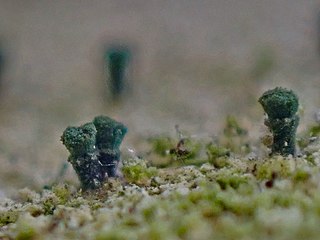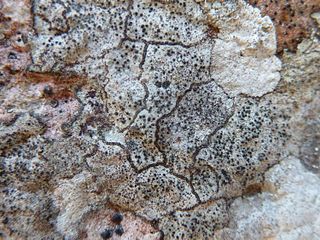
Eurotiomycetes is a large class of ascomycetes with cleistothecial ascocarps within the subphylum Pezizomycotina, currently containing around 3810 species according to the Catalogue of Life. It is the third largest lichenized class, with more than 1200 lichen species that are mostly bitunicate in the formation of asci. It contains most of the fungi previously known morphologically as "Plectomycetes".

Capnodiales is a diverse order of Dothideomycetes, initially based on the family Capnodiaceae, also known as sooty mold fungi. Sooty molds grow as epiphytes, forming masses of black cells on plant leaves and are often associated with the honeydew secreted by insects feeding on plant sap. This diverse order has been expanded by the addition of several families formerly thought unrelated and now also includes saprobes, endophytes, plant pathogens, lichens and rock-inhabiting fungi. The new additions include the genus Mycosphaerella containing the causal agents of several economically important crop and tree diseases. A small number of these fungi are also able to parasitise humans and animals, including species able to colonise human hair shafts.

The Mycocaliciaceae are a family of seven genera and about 90 species of fungi in the order Mycocaliciales.

Anisomeridium is a genus of lichens in the family Monoblastiaceae. The type species was originally named Arthopyrenia xylogena by Swiss botanist Johannes Müller Argoviensis in 1883; in 1928, Maurice Choisy defined the genus Anisomeridium, designating A. xylogena the type species.
Clavascidium is a genus of lichens in the family Verrucariaceae. The genus was circumscribed in 1996 by Austrian lichenologist Othmar Breuss. Because the type species of the genus, Clavascidium umbrinum, has been shown using molecular phylogenetics to belong to genus Placidium, Cécile Gueidan and colleagues proposed to unite Clavascidium with Placidium in a 2009 publication. Despite this, the genus has been retained in recent publications of fungal classification.
Polyblastia is a genus of lichenized fungi in the family Verrucariaceae. As of 2020, it consists of about 40 species combined with about 50 orphaned species. The main difference with the genus Verrucaria is related to spores, which are muriform in Polyblastia.

Microcalicium is a genus of lichen-forming fungi in the order Pertusariales. It is the only genus in the monotypic family Microcaliciaceae. These taxa were circumscribed by the Finnish lichenologist Edvard August Vainio in 1927, with Microcalicium disseminatum assigned as the type species.
Allophoron is a genus of fungi in the division Ascomycota. The relationship of this taxon to other taxa within the division is unknown, and it has not yet been placed with certainty into any class, order, or family. This is a monotypic genus, containing the single lichen species Allophoron farinosum, found in Colombia. The genus and species were described as new in 1942 by Czech lichenologist Josef Nádvorník.
Tylophoron is a genus of lichen-forming fungi in the family Arthoniaceae. The genus was circumscribed in 1862 by Finnish lichenologist William Nylander.

Chaenothecopsis is a genus of about 40 species of pin lichens in the family Mycocaliciaceae.

Phaeocalicium is a genus of fungi in the family Mycocaliciaceae. The genus was circumscribed in 1970 by German lichenologist Alexander Schmidt, with Phaeocalicium praecedens assigned as the type species.
Stenocybe is a genus of fungi in the family Mycocaliciaceae. It has 14 species.
Tylophorella is a genus of lichen-forming fungi in the order Arthoniales. The genus has not been placed into a family. Tylophorella was circumscribed by Finnish lichenologist Edvard August Vainio in 1890, with Tylophorella polyspora assigned as the type species. T. pyrenocarpoides was added to the genus in 1993.
Wegea is a genus of fungi within the order Arthoniales. The genus has not been placed into a family. This is a monotypic genus, containing the single species Wegea tylophorelloides. The genus was circumscribed in 1997 by André Aptroot and Leif Tibell. The species have a morphology similar to calicioid fungi but does not form a mazaedium.

Thamnolia is a genus of lichens in the family Icmadophilaceae. Members of the genus are commonly called whiteworm lichens.

The Caliciaceae are a family of mostly lichen-forming fungi belonging to the class Lecanoromycetes in the division Ascomycota. Although the family has had its classification changed several times throughout its taxonomic history, the use of modern molecular phylogenetic methods have helped to establish its current placement in the order Caliciales. Caliciaceae contains 39 genera and about 670 species. The largest genus is Buellia, with around 300 species; there are more than a dozen genera that contain only a single species.
Chaenothecopsis vainioana is a species of lichenicolous fungus in the family Caliciaceae that is found in Europe. It was first formally described by Czech lichenologist Josef Nádvorník in 1940 as a member of the genus Calicium. The specific epithet honours Finnish lichenologist Edvard August Vainio. Leif Tibell transferred it to genus Chaenothecopsis in 1979. Calicium vainioanum has been reported growing on Arthonia, Lecanactis abietina, and Calicium salicinum.
Leif Tibell is a Swedish lichenologist and Emeritus Professor at the University of Uppsala. He is known for his expertise on calicioid lichens. He was awarded the Acharius Medal in 2012 for lifetime achievements in lichenology.

Parabagliettoa is a genus of crustose lichens in the family Verrucariaceae. It has 3 species. The genus was circumscribed in 2009 by Cécile Gueidan and Claude Roux, with Parabagliettoa dufourii assigned as the type species.
Atla is a genus of crustose lichens in the family Verrucariaceae. It has nine species that grow on rocks or on soil.










